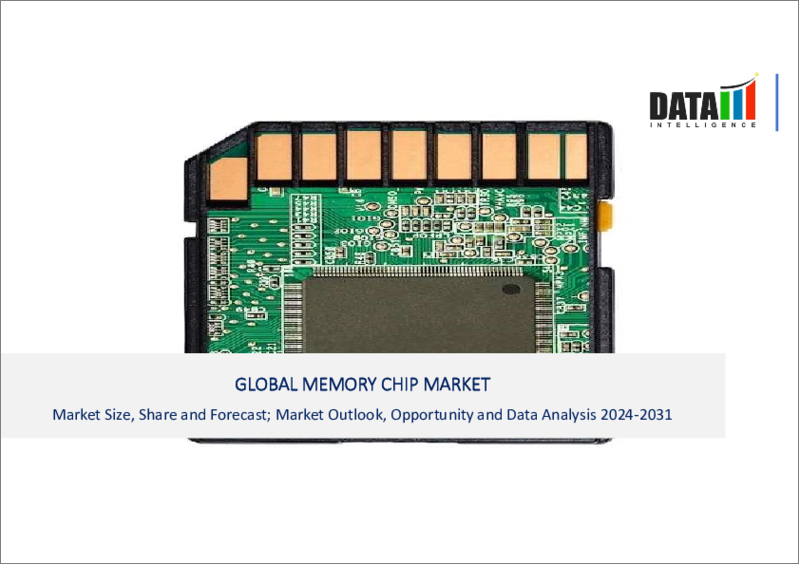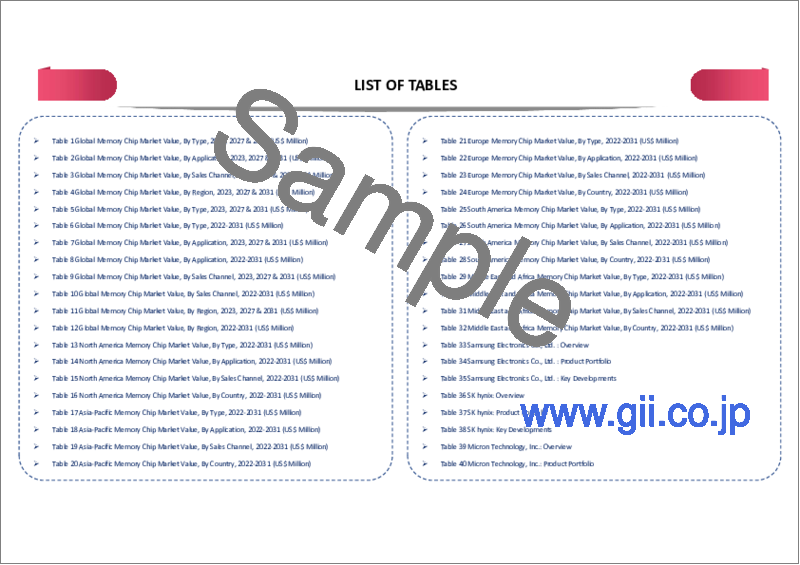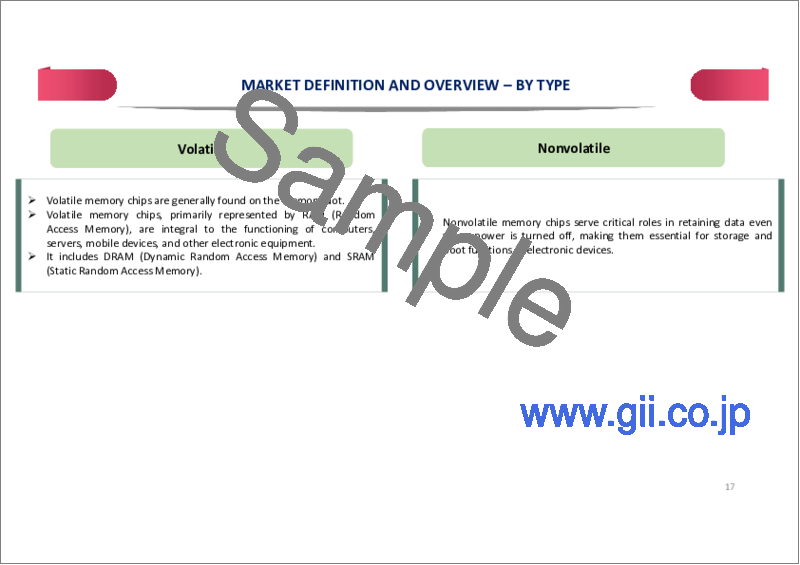|
|
市場調査レポート
商品コード
1396632
メモリチップの世界市場-2023年~2030年Global Memory Chip Market - 2023-2030 |
||||||
カスタマイズ可能
適宜更新あり
|
|||||||
| メモリチップの世界市場-2023年~2030年 |
|
出版日: 2023年12月15日
発行: DataM Intelligence
ページ情報: 英文 192 Pages
納期: 即日から翌営業日
|
- 全表示
- 概要
- 目次
概要
世界のメモリチップ市場は、2022年に1,785億米ドルに達し、2030年には4,559億米ドルに達すると予測され、予測期間2023-2030年のCAGRは12.5%で成長する見込みです。
メモリチップ市場は、次世代コネクテッドカーや自動車安全システムにおけるメモリーやストレージデバイスの需要の高まりにより、大きな成長を遂げています。これらのシステムは、デジタル・データの保存に半導体メモリに依存しているため、半導体メモリはプロセッサやコントローラを備えたデバイスに不可欠な要素となっています。
さらに、データセンターの建設が世界的に増加し、さまざまな企業のストレージ要件が半導体ベースのメモリ・デバイスの需要を押し上げています。特に先進国のコロケーションやハイパースケールデータセンターが、膨大な企業データを管理・保存するための半導体メモリへのニーズを後押ししています。
アジア太平洋地域は、堅調な民生用電子機器産業とハイエンド電子機器への注力により、メモリチップ市場で最大のシェアを占めています。同地域は、2024年までに5G携帯電話の出荷台数が国内市場を席巻するよう努力しており、主要なコンピューター、通信、電子機器メーカーが安定的に成長していることが、同市場のリーダーシップに寄与しています。また、中国が消費者向け電子機器の輸出に重点を置き、越境eコマース事業を拡大していることも、メモリチップ市場における中国の地位をさらに強固なものにしています。
力学
メモリチップの進歩
メモリチップ市場は、より小型で効率的、かつ大容量のメモリチップの開発と進歩の拡大によって牽引されると予想されます。小型化と革新的な製造技術により、記憶容量が増加し、性能が向上したメモリチップの製造が可能になっています。小型化されたチップは、スマートフォンからデータセンターまで、さまざまな機器に応用され、市場の成長に貢献しています。また、3Dスタッキングや新たな不揮発性メモリ技術などの進歩が、メモリチップの状況をさらに形成しています。
例えば、SKハイニックスは、従来のメモリとプロセッサの役割に課題するコンピューティング機能を備えた次世代メモリチップ、PIMを開発しました。この開発は、半導体メモリが中心的な役割を果たすメモリ中心コンピューティングへの道を開くものです。SKハイニックスのGDDR6-AiMは、GDDR6メモリチップに計算機能を追加し、CPUまたはGPUと組み合わせることでデータ処理速度を16倍に加速し、機械学習、高性能コンピューティング、ビッグデータタスクに適しています。
自動車産業と新技術の成長
メモリチップ市場の世界の成長は、新興技術とメモリ集約型アプリケーションの需要増加が牽引しています。特に自動車産業は、高度なメモリチップ技術によって大きな変革期を迎えています。不揮発性メモリチップは、停電時のデータ整合性を確保し、自動車の性能を高める上で極めて重要なものとなっています。高密度のメモリチップは、物理的なスペースの制約にもかかわらず、コネクテッドカーや自律走行車が大量のデータを効率的に管理することを可能にしています。
世界最大のメモリチップ・メーカーであるサムスン電子は、2027年までにeMRAMと呼ばれる次世代5ナノメーター・プロセスの車載用メモリチップを開発する計画を発表しました。eMRAM技術は、高温下でも安定して動作し、高速な読み出し・書き込みが可能な車載アプリケーションに不可欠な技術です。サムスンは14nm eMRAMの開発に積極的に取り組んでおり、2024年までに発表することを目指しています。
顧客受注の減少と過剰供給
メモリチップ市場は、倉庫に備蓄された過剰供給、顧客からの注文の減少、製品価格の大幅下落という厳しい抑制要因に直面しています。この課題により、この時期はメモリチップ産業史上最も厳しい時期のひとつとなっています。
さらに、市場はインフレや金利上昇など外部からの経済圧力と戦っており、消費者や企業はパソコンやスマートフォンなどメモリーを多用する機器への大幅な投資を先送りしています。その結果、大手メモリチップメーカーは多額の財務的損失を被り、余剰在庫の問題を悪化させ、市場における需要の乏しさを際立たせています。こうした複合的な要因が、メモリチップ業界にとって複雑で困難な情勢を生み出し、業界全体の安定性と収益性に影響を及ぼしています。
目次
第1章 調査手法と調査範囲
第2章 定義と概要
第3章 エグゼクティブサマリー
第4章 市場力学
- 影響要因
- 促進要因
- メモリチップの進歩
- 自動車産業の成長と新興技術
- 抑制要因
- 顧客からの注文の減少と過剰供給
- 機会
- 影響分析
- 促進要因
第5章 産業分析
- ポーターのファイブフォース分析
- サプライチェーン分析
- 価格分析
- 規制分析
第6章 COVID-19分析
第7章 タイプ別
- 揮発性
- DRAM
- SRAM
- 不揮発性
- PROM
- EEPROM
- NANDフラッシュ
- その他
第8章 用途別
- ラップトップ/PC
- カメラ
- スマートフォン
- その他
第9章 地域別
- 北米
- 米国
- カナダ
- メキシコ
- 欧州
- ドイツ
- 英国
- フランス
- イタリア
- ロシア
- その他欧州
- 南米
- ブラジル
- アルゼンチン
- その他南米
- アジア太平洋
- 中国
- インド
- 日本
- オーストラリア
- その他アジア太平洋地域
- 中東・アフリカ
第10章 競合情勢
- 競合シナリオ
- 市況/シェア分析
- M&A分析
第11章 企業プロファイル
- Samsung Electronics
- 会社概要
- 製品ポートフォリオと説明
- 財務概要
- 主な発展
- SK hynix
- Micron Technology
- Kioxia
- Western Digital
- HP Inc.
- Qualcomm
- Broadcom
- Texas Instruments
- Renesas Electronics
第12章 付録
Overview
Global Memory Chip Market reached US$ 178.5 billion in 2022 and is expected to reach US$ 455.9 billion by 2030, growing with a CAGR of 12.5% during the forecast period 2023-2030.
The memory chip market is experiencing significant growth due to the rising demand for memory and storage devices in next-generation connected cars and automotive safety systems. The systems rely on semiconductor memory for digital data storage, making semiconductor memory an integral part of devices with processors or controllers.
Moreover, the increasing construction of data centers globally and the storage requirements of various enterprises are boosting the demand for semiconductor-based memory devices. Colocation and hyperscale data centers, especially in developed nations, are driving the need for semiconductor memory to manage and store vast amounts of corporate data.
Asia-Pacific holds the largest share in the memory chip market due to its robust consumer electronics industry and a focus on high-end electronic devices. The region's efforts to ensure 5G mobile phone shipments dominate the domestic market by 2024 and the stable growth of major computer, communications and electronic device manufacturers contribute to its market leadership. Also, China's emphasis on exporting consumer electronic devices and expanding cross-border e-commerce businesses further solidifies its position in the memory chip market.
Dynamics
Memory Chip Advancements
The memory chip market is expected to driven with the growing advancement and also the development of smaller, more efficient and higher-capacity memory chips. Miniaturization and innovative manufacturing techniques allow for the production of memory chips with increased storage capacity and enhanced performance. The smaller chips find applications in various devices, from smartphones to data centers, contributing to the market's growth. Also, advancements like 3D stacking and emerging non-volatile memory technologies are further shaping the memory chip landscape
SK hynix, for instance, developed PIM, a next-generation memory chip with computing capabilities that challenge traditional roles of memory and processors. The development paves the way for memory-centric computing, where semiconductor memory plays a central role. SK hynix's GDDR6-AiM adds computational functions to GDDR6 memory chips and accelerates data processing speeds by 16 times when it combined with a CPU or GPU, making it suitable for machine learning, high-performance computing and big data tasks.
Growth of Automotive Industry and Emerging Technologies
The globally growth of the memory chip market is driven by emerging technologies and increasing demand for memory-intensive applications. The automotive industry, in particular, is undergoing significant transformation due to advanced memory chip technologies. Non-volatile memory chips, ensuring data integrity during power failures and enhancing vehicle performance, have become pivotal. High-density memory chips are enabling connected and autonomous vehicles to efficiently manage large volumes of data despite physical space constraints.
Samsung Electronics, the world's largest memory chipmaker, has announced its plans to develop a next-generation 5-nanometer-processed automotive memory chip, called eMRAM, by 2027. The eMRAM technology is vital for automotive applications, operating stably even at high temperatures with fast read and write speeds. Samsung is actively working on a 14 nm eMRAM and aims to unveil it by 2024.
Dwindling Customer Orders and Excessive Supply
The memory chip market faces formidable restraints characterized by an excessive supply of chips stockpiled in warehouses, dwindling customer orders and a substantial drop in product prices. The challenges have rendered this period one of the most demanding in the history of the memory chip industry.
Furthermore, the market contends with external economic pressures, including inflation and rising interest rates, leading consumers and businesses to defer substantial investments in memory-intensive devices such as computers and smartphones. Consequently, major memory chip manufacturers have suffered significant financial losses, exacerbating the issue of surplus inventory and highlighting a conspicuous dearth of demand in the market. The combined factors create a complex and challenging landscape for the memory chip industry, impacting its overall stability and profitability.
Segment Analysis
The global memory chip market is segmented based on type, application and region.
DRAM Dominates the Memory Chip Market Amid Technological Advancements
Dynamic Random Access Memory (DRAM) holds the largest share in the memory chip market due to its indispensable role in modern computing. DRAM provides fast, volatile storage vital for various applications. As technology advances and demands for higher performance and memory density increase, DRAM manufacturers face challenges in scaling down to and beyond the 10 nm process. The primary issue is reducing cell capacitance without compromising data retention or memory density.
Manufacturers employ advanced materials, including high-k dielectrics, to enhance individual cell capacitance. Three-dimensional (3D) integration is a critical development, as it involves vertically stacking multiple layers of memory cells, bypassing lateral scaling limitations. Advanced lithography techniques such as extreme ultraviolet (EUV) lithography enable finer dimensions, enhancing DRAM cell performance.
Major players in the DRAM industry, like Samsung, are driving innovation. Samsung introduced a 16 GB, 12 nm DDR5 DRAM featuring refined circuitry, optimized cell structures and reduced power consumption while increasing wafer productivity. Samsung also unveiled the industry's first Compute Express Link (CXL) DRAM, aiming to bridge memory and high-performance computing. Other manufacturers, such as Micron, are embracing EUV lithography to advance their DRAM portfolios.
Micron is planning to introduce EUV lithography in Japan for its next-generation DRAM, the 1-gamma (1γ) node, to achieve faster, more power-efficient and higher-performance memory products. Meanwhile, startups like NEO Semiconductor are making strides with innovative approaches like 3D X-DRAM, which leverages 3D integration to overcome conventional DRAM limitations.
Geographical Penetration
Asia-Pacific Leads the Memory Chip Market, Fueled by Electronics Manufacturing Hubs
Asia-Pacific commands the largest share in the memory chip market due to its prominent electronics manufacturing hubs, including China, South Korea and Taiwan. The countries are major producers of smartphones, computers and various electronic devices which is simultaneously driving significant demand for memory chips in the region.
According to Invest India, India is rapidly emerging as a global electronics manufacturing hub with the industry projected to reach US$ 300 billion by 2025 and 2026. The growth is driven by government initiatives promoting domestic electronics manufacturing, such as the Production Linked Incentive scheme. India's domestic demand for consumer electronics is on the surge and the country have become home to the world's second-largest smartphone market.
Competitive Landscape
The major global players in the market include: Samsung Electronics, SK hynix, Micron Technology, Kioxia, Western Digital, HP Inc., Qualcomm, Broadcom, Texas Instruments, Renesas Electronics.
COVID-19 Impact Analysis
COVID-19 pandemic had a significant impact on the memory chip market. Initially, the market experienced disruptions in the supply chain, particularly from Asia, which is a major hub for semiconductor manufacturing. Lockdowns and restrictions led to factory closures and labor shortages, affecting production.
Amidst a surge in remote work and increased online activities, the demand for memory-intensive devices such as laptops, tablets and smartphones witnessed a notable upswing. The resulted in a temporary spike in demand; however, manufacturers faced challenges in meeting this heightened need due to disruptions in the supply chain. As the pandemic persisted, economic uncertainties and a decrease in consumer spending exerted a detrimental influence on the market. Numerous industries and consumers opted to defer or reduce their purchases of electronic devices, subsequently affecting the stability and profitability of the memory chip market.
Russia-Ukraine War Impact
The Russia-Ukraine war had a significant impact on the memory chip market due to the interconnectedness of global supply chains and geopolitical tensions. Ukraine is a major producer of neon gas, a critical component used in the manufacturing of memory chips. The conflict disrupted the supply of neon gas, leading to shortages and price increases in the semiconductor industry.
Furthermore, the war caused uncertainty in global markets, leading to fluctuations in currency exchange rates and increased production costs for memory chip manufacturers. The, in turn, affected pricing and profit margins in the memory chip market.
By Type
- Volatile
- DRAM
- SRAM
- Nonvolatile
- PROM
- EEPROM
- NAND Flash
- Others
By Application
- Laptop/PC
- Camera
- Smartphone
- Others
By Region
- North America
- U.S.
- Canada
- Mexico
- Europe
- Germany
- UK
- France
- Italy
- Russia
- Rest of Europe
- South America
- Brazil
- Argentina
- Rest of South America
- Asia-Pacific
- China
- India
- Japan
- Australia
- Rest of Asia-Pacific
- Middle East and Africa
Key Developments
- In July 2023, China's leading memory chip producer, Yangtze Memory Technologies Co (YMTC), has developed the "world's most advanced" 3D NAND memory chip found in a consumer device. Despite facing sanctions and being placed on US Commerce Department's Entity List, YMTC introduced this groundbreaking memory chip in a solid-state drive quietly launched.
- In October 2023, Apple unveiled a trio of groundbreaking chips for personal computers: M3, M3 Pro and M3 Max. The chips are the industry's first to utilize 3-nanometer process technology, enabling more transistors to be packed into a smaller space, leading to significant speed and efficiency improvements. The M3 family introduces a next-generation GPU that boasts remarkable advancements in graphics architecture. It features Dynamic Caching, hardware-accelerated ray tracing and mesh shading, resulting in rendering speeds up to 2.5 times faster than the previous M1 chips.
- On July 20, 2023, Samsung announced the completion of its GDDR7 memory development, which is slated to be featured in the next-generation high-end graphics cards. The first-generation GDDR7 memory chip boasts an impressive 16 GB capacity, providing a substantial 1.5 TB/s of bandwidth, making it 40% faster than the current high-speed GDDR6 memory with a peak bandwidth of 1.1 TB/s.
Why Purchase the Report?
- To visualize the global memory chip market segmentation based on type, application and region, as well as understand key commercial assets and players.
- Identify commercial opportunities by analyzing trends and co-development.
- Excel data sheet with numerous data points of memory chip market-level with all segments.
- PDF report consists of a comprehensive analysis after exhaustive qualitative interviews and an in-depth study.
- Product mapping available as excel consisting of key products of all the major players.
The global memory chip market report would provide approximately 53 tables, 47 figures and 192 Pages.
Target Audience 2023
- Manufacturers/ Buyers
- Industry Investors/Investment Bankers
- Research Professionals
- Emerging Companies
Table of Contents
1. Methodology and Scope
- 1.1. Research Methodology
- 1.2. Research Objective and Scope of the Report
2. Definition and Overview
3. Executive Summary
- 3.1. Snippet by Type
- 3.2. Snippet by Application
- 3.3. Snippet by Region
4. Dynamics
- 4.1. Impacting Factors
- 4.1.1. Drivers
- 4.1.1.1. Memory Chip Advancements
- 4.1.1.2. Growth of Automotive Industry and Emerging Technologies
- 4.1.2. Restraints
- 4.1.2.1. Dwindling Customer Orders and Excessive Supply
- 4.1.3. Opportunity
- 4.1.4. Impact Analysis
- 4.1.1. Drivers
5. Industry Analysis
- 5.1. Porter's Five Force Analysis
- 5.2. Supply Chain Analysis
- 5.3. Pricing Analysis
- 5.4. Regulatory Analysis
6. COVID-19 Analysis
- 6.1. Analysis of COVID-19
- 6.1.1. Scenario Before COVID
- 6.1.2. Scenario During COVID
- 6.1.3. Scenario Post COVID
- 6.2. Pricing Dynamics Amid COVID-19
- 6.3. Demand-Supply Spectrum
- 6.4. Government Initiatives Related to the Market During Pandemic
- 6.5. Manufacturers Strategic Initiatives
- 6.6. Conclusion
7. By Type
- 7.1. Introduction
- 7.1.1. Market Size Analysis and Y-o-Y Growth Analysis (%), By Type
- 7.1.2. Market Attractiveness Index, By Type
- 7.2. Volatile*
- DRAM
- SRAM
- 7.2.1. Introduction
- 7.2.2. Market Size Analysis and Y-o-Y Growth Analysis (%)
- 7.3. Nonvolatile
- PROM
- EEPROM
- NAND Flash
- Others
8. By Application
- 8.1. Introduction
- 8.1.1. Market Size Analysis and Y-o-Y Growth Analysis (%), By Application
- 8.1.2. Market Attractiveness Index, By Application
- 8.2. Laptop/PC*
- 8.2.1. Introduction
- 8.2.2. Market Size Analysis and Y-o-Y Growth Analysis (%)
- 8.3. Camera
- 8.4. Smartphone
- 8.5. Others
9. By Region
- 9.1. Introduction
- 9.1.1. Market Size Analysis and Y-o-Y Growth Analysis (%), By Region
- 9.1.2. Market Attractiveness Index, By Region
- 9.2. North America
- 9.2.1. Introduction
- 9.2.2. Key Region-Specific Dynamics
- 9.2.3. Market Size Analysis and Y-o-Y Growth Analysis (%), By Type
- 9.2.4. Market Size Analysis and Y-o-Y Growth Analysis (%), By Application
- 9.2.5. Market Size Analysis and Y-o-Y Growth Analysis (%), By Country
- 9.2.5.1. U.S.
- 9.2.5.2. Canada
- 9.2.5.3. Mexico
- 9.3. Europe
- 9.3.1. Introduction
- 9.3.2. Key Region-Specific Dynamics
- 9.3.3. Market Size Analysis and Y-o-Y Growth Analysis (%), By Type
- 9.3.4. Market Size Analysis and Y-o-Y Growth Analysis (%), By Application
- 9.3.5. Market Size Analysis and Y-o-Y Growth Analysis (%), By Country
- 9.3.5.1. Germany
- 9.3.5.2. UK
- 9.3.5.3. France
- 9.3.5.4. Italy
- 9.3.5.5. Russia
- 9.3.5.6. Rest of Europe
- 9.4. South America
- 9.4.1. Introduction
- 9.4.2. Key Region-Specific Dynamics
- 9.4.3. Market Size Analysis and Y-o-Y Growth Analysis (%), By Type
- 9.4.4. Market Size Analysis and Y-o-Y Growth Analysis (%), By Application
- 9.4.5. Market Size Analysis and Y-o-Y Growth Analysis (%), By Country
- 9.4.5.1. Brazil
- 9.4.5.2. Argentina
- 9.4.5.3. Rest of South America
- 9.5. Asia-Pacific
- 9.5.1. Introduction
- 9.5.2. Key Region-Specific Dynamics
- 9.5.3. Market Size Analysis and Y-o-Y Growth Analysis (%), By Type
- 9.5.4. Market Size Analysis and Y-o-Y Growth Analysis (%), By Application
- 9.5.5. Market Size Analysis and Y-o-Y Growth Analysis (%), By Country
- 9.5.5.1. China
- 9.5.5.2. India
- 9.5.5.3. Japan
- 9.5.5.4. Australia
- 9.5.5.5. Rest of Asia-Pacific
- 9.6. Middle East and Africa
- 9.6.1. Introduction
- 9.6.2. Key Region-Specific Dynamics
- 9.6.3. Market Size Analysis and Y-o-Y Growth Analysis (%), By Type
- 9.6.4. Market Size Analysis and Y-o-Y Growth Analysis (%), By Application
10. Competitive Landscape
- 10.1. Competitive Scenario
- 10.2. Market Positioning/Share Analysis
- 10.3. Mergers and Acquisitions Analysis
11. Company Profiles
- 11.1. Samsung Electronics*
- 11.1.1. Company Overview
- 11.1.2. Product Portfolio and Description
- 11.1.3. Financial Overview
- 11.1.4. Key Developments
- 11.2. SK hynix
- 11.3. Micron Technology
- 11.4. Kioxia
- 11.5. Western Digital
- 11.6. HP Inc.
- 11.7. Qualcomm
- 11.8. Broadcom
- 11.9. Texas Instruments
- 11.10. Renesas Electronics
LIST NOT EXHAUSTIVE
12. Appendix
- 12.1. About Us and Services
- 12.2. Contact Us






